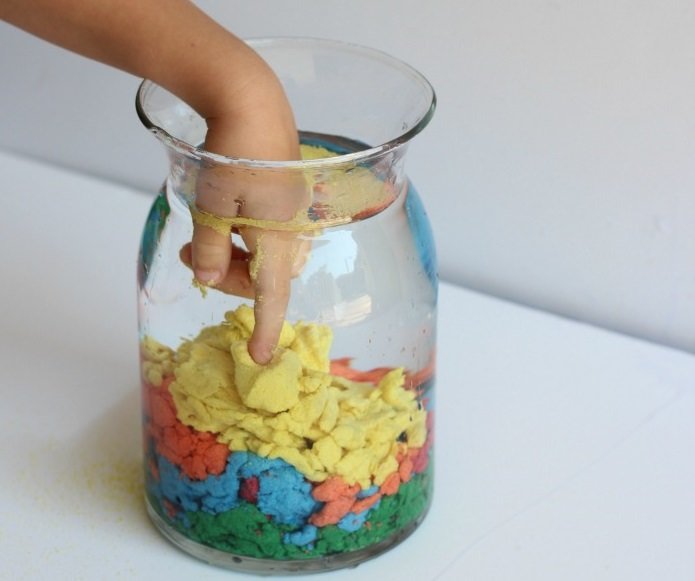Prepare to mesmerize your little ones and watch as their eyes light up with delight!
I do all sorts of experiments and STEM activities with my pre-schooler, mostly because he would drive me berserk if I didn't find things that would keep him out of trouble, but also, because I feel very strongly that our children are never too early to be introduced to the wonderful world of learning through fun and experimentation.
This nifty science "trick" or little bit of magic as I like to call it is very easy to administer and is suitable for parents to do at home with their own kids, or, if you are a teacher, this can also be done as a group activity for all to enjoy. Heck, this one is so awesome even the adults are likely to get a kick out of it!

THE MAGIC OF UNDERWATER SAND
Personally, I love activities that are easy on the pocket, require basic “ingredients”, are safe to do and easy to clean up! This one hits the nail on the head with everything, except the cleaning up part that is!
To do this experiment, you will need the following ingredients and apparatus:
- Clean sand, plain or coloured (you can colour sand with food colouring)
- Water
- A clear bowl, vase or large beaker
- Baking tray
- Wax paper
- Spoon
- Fabric protector spray (like Scotch Guard)
- Extra containers if you are using different colours of sand
The experiment:
- Line your baking tray with wax paper.
- Spread the sand over the wax paper
- Spray a heavy coat of fabric protector on to the sand and leave to stand for 10 minutes.
- Mix the sand up a bit and then spray with another heavy coat of Scotch Guard.
- Leave the sand to dry for about an hour or so.
- If you are using coloured sand, pour each colour into a separate container.
- Fill your beaker or transparent dish with water.
- Pour your sand into the water and observe.
- The water will fall but will also clump together, instead of sinking to the bottom to form one layer (like it would without the Scotch Guard).


* Allow your little scientists to scoop some of the sand out of the water, it will separate in their hands, but clump back together again once they release it back into the water! MAGIC!
THE SCIENCE BIT
Unlike normal sand, magic sand has a hydrophobic surface that repels water, so it does not get wet. Instead, magic sand clumps together under water and behaves unlike normal. - https://www.scienceinschool.org/content/magic-sand-mystery
Source Link: https://teachingmama.org/underwater-magic-sand/
Like all of the experiments I share with you, this one can also be adapted to be more challenging or theoretical depending on the age group of the child/children you are working with. For toddlers and pre-schoolers, you could keep it to a sensory activity and perhaps add plain sand to another beaker of water so that they can observe the difference between magic sand and plain sand in water. With older kids, you could go into more theoretical detail about what hydrophobics is and how it works.
Much love - @sweetpea


Very interesting to know!
Will definitely AMAZE my sister's 2 rugrats! :-)
Thanks for sharing!
Keep on steeming!
Nice piece of work, something like this I have seen where the guy was having a material which is same hydrophobic and the molecules are attached in such a way that it can sustains the pressure of 20 times more and when gently can deform the structure but can not change when hammered.
Wow.. it looks fun.. thank you for the knowledge..
Wow.. it looks fun.. thank you for the knowledge..
That looks like so much fun! Thanks for sharing, I am sure the kids love it.
amazing! this is such a great idea. i dont have kids, but may try this out anyways for myself lol
Thanks, this sounds interesting, i would try this one even though i have no kids heheheh
In particular I love the experiences for children, my daughter and I have been doing a series of post about home experiments and she was very funny and learned a lot! I love your experiment! Regards!!
wow, that is real fun. shared on twitter.
You do a surprising and entertaining work with these experiences, without a doubt, children will not get bored, because they are very active and fascinating experiences and easy to understand.
You have been upvoted by the @sndbox-alpha! Our curation team is currently formed by @bitrocker2020, @zord189, @aaronleang, & @teachblogger . We are seeking posts of the highest quality and we deem your endeavour as one of them. If you want to get to know more, feel free to check our blog.
Thanks for sharing the experiment. I also do believe that it is never too early to expose our little ones. I am hoping to do more of this with my 2 and 4 year old boys too! Keep them coming!